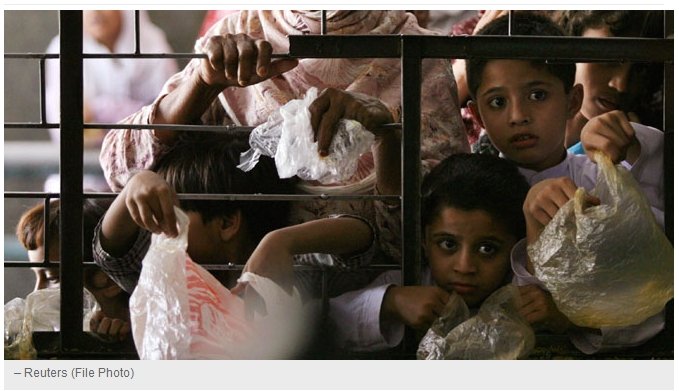
ISLAMABAD, July 4: The food security situation in Pakistan has worsened over the past four years, resulting in a drastic increase in the proportion of population falling below the minimum acceptable level of dietary consumption, according to a United Nations report.
According to the United Nations Millennium Development Goals report for 2012, two-digit inflation and high food inflation significantly decreased the purchasing power of people, especially the poor.
The report expressed fears that Pakistan was lagging behind the target of eradicating extreme poverty and hunger and indicators show that the target would not be achieved by 2015, the deadline for achieving MDGs.
The report expressed concern over a number of factors that have contributed to under-achievement against most of MDGs.
These include the slow economic growth or less than three per cent over the last three to four years.
With a labour force increasing at a rate of 3.2 per cent, the slow economic growth is not creating sufficient jobs for the new entrants to the labour market.
Besides poverty and unemployment issues, the income inequality in the country has always been on the rise. The share of consumption of the lowest quintile is currently 9.6 per cent against 40.3 per cent for the highest quintile. There also exist widespread gender inequalities.
The share of women in wage employment is the slowest in South Asia and Pakistan is not an exception to it.
Additionally, there are regional pockets where status of development is worst than other areas.
Notwithstanding the challenges, the report said, there are a number of opportunities to build on.
The increase in the share of provinces in NFC award and the 18th Amendment for decentralisation of governance at the provincial level will help development partners to work more closely with the end beneficiaries.
According to the report, Pakistan adopted 18 targets and 41 indicators against which the progress is measured. However, time series data against only 33 indicators were available.Of the total 33 indicators, progress on 20 indicators is lagging behind, slow on four indicators, on track three indicators, off-track one indicator while targets against five indicators have been met.
On a total of five indicators, Pakistan is either ahead or has achieved the target.
With regard to access to improved water source, Pakistan achieved the target when three sources of improved water, tap water, hand pumps and electric motor propelled water, are taken into account.However, the Pakistan MDG report of 2010 has not included ‘electric motor’ in the category of improved water source which makes the status at around 63 per cent against the 92 per cent.
According to the report, Pakistan has made some progress in combating HIV/Aids, malaria and other diseases; and promoting gender equality and women empowerment. However, progress rate is slow and additional efforts will be needed if the targets are to be achieved by the 2015 deadline.
On a positive note, the report recognised that Pakistan has one of the highest ratios of women parliamentarians in South Asia.
While bullish on the success recorded, the MDG report warns that the 2015 deadline is fast approaching and in order to achieve outstanding goals, governments, the international community, civil society and the private sector need to intensify their contributions.

